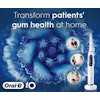
If you poll most people, they will separate the mouth from the rest of the body, but doing so has sometimes severe repercussions. More and more evidence demonstrates that oral health is linked to overall health.
People who neglect the mouth are at increased risk of developing diabetes, hypertension, stroke, Alzheimer’s disease, and even hair loss. These are the diseases the dental community knows about -- new connections are discovered with increasing frequency.
One disease that has extensive research proving the link between it and poor oral health is diabetes. More than a decade ago, researchers learned that tissue inflammation caused by oral bacteria weakens the body’s ability to use insulin and control blood sugar.
This effect then provides optimal conditions for more bacteria to grow, which further exacerbates the problem of controlling blood sugar. In other words, bad bacteria harm sugar control, produce more sugar, and then increase the likelihood of diabetes. A cascade of health consequences occurs because bad bacteria in the mouth breach the body’s protective barriers and enter the circulatory system, causing a whole host of problems.
Diabetes is one problem that arises when certain bacteria enter the circulatory system but there are others, including hypertension. Recently, a Journal of Dentistry study showed the relationship between tooth loss and hypertension is likely bidirectional. The research team observed a positive association when severe tooth loss was set as the exposure component and hypertension as the outcome.
Poor oral health and cardiovascular problems
People with severe tooth loss had a 12% increased risk of hypertension, and the risk increased another 12% for every seven missing teeth. Not only that, patients with moderate to severe periodontitis had a 20% greater risk of hypertension. That’s one direction. In the other direction, study participants with hypertension had an increased risk of tooth loss compared to people who had normal blood pressure.
Why does this happen? Toxic products, systemic inflammatory mediators, and bacteria lead to vascular inflammation and endothelial dysfunction that affect hypertension. Systemic inflammation related to hypertension may also activate local inflammation and release periodontal inflammatory mediators that destroy periodontal tissues, eventually leading to tooth loss.
The connection between hypertension and tooth loss is so established that researchers are using machine learning to predict cardiovascular disease (CVD) based on decayed, missing, or filled teeth and surfaces (DMFS). University of Pittsburgh researchers reported a significant association between DMFS and CVD (p = 0.0027) after controlling for the age of 5,188 study participants. The machine-learning model demonstrated 84.3% accuracy in predicting CVD based on an individual's DMFS score.
In other words, yes, there’s an association between dental caries and CVD -- and it’s high. It’s not only general tooth loss but a particular bacterium that can increase the risk of a cardiovascular event, according to Swiss Federal Institute of Technology Lausanne researchers.
In a study of 3,459 people, the researchers reported that antibodies made against Fusobacterium nucleatum were linked with a slightly increased risk of a cardiovascular event. The bacteria may increase cardiovascular risk because of higher systemic inflammation due to the presence of bacteria in the mouth or through colonization of the arterial walls or plaque lining the arterial walls. The answer isn’t clear yet and more research is needed, but something is happening such that F. nucleatum increases the risk of a cardiovascular event.
Poor oral health and the brain
Bacteria are the culprit behind many health ailments, as researchers have also documented a connection between the bacteria Streptococcus mutans (S. mutans) and higher numbers of deep and lobar cerebral microbleeds. A multinational team conducted a retrospective study of 428 stroke patients who had undergone oral bacterial exams and found it wasn’t only the presence of S. mutans that mattered, it was also the appearance of the collagen-binding protein Cnm.
Cnm-positive S. mutans induced cerebrovascular inflammation, impaired the blood-brain barrier, and caused brain bleeding. This protein lives in dental plaque and was related to more than 10 cerebral microbleeds, which are a predictor of future intracranial hemorrhage, ischemic stroke, and mortality.
After adjusting for age, sex, hypertension, stroke type, and cerebral amyloid angiopathy, there were higher numbers of deep (adjusted risk ratio, 1.61) and lobar (adjusted risk ratio, 5.14) cerebral microbleeds, the researchers reported. Reducing the bacteria in the oral cavity could be a new treatment for stroke patients because cerebral microbleeds affect the long-term prognosis of stroke patients, they added.
It's not only strokes that could be prevented by better oral health, Alzheimer’s disease could also potentially be warded off. A group in Japan asserted that gum disease and tooth loss may be linked to brain shrinkage in the hippocampus, which is a region that has significant ties to memory and Alzheimer’s disease.
After adjusting for age, the study showed the increase in the rate of brain shrinkage due to one less tooth was equivalent to nearly one year of brain aging in patients with mild gum disease. For patients with severe gum disease, the increase in brain shrinkage due to one more missing tooth was equivalent to 1.3 years of brain aging, which suggests that retaining teeth with severe gum disease is associated with brain atrophy.
Gum disease must be treated to prevent not only mouth pain but also Alzheimer’s. Research has shown in patients with periodontal disease that the bacteria Porphyromonas gingivalis are released, which discharges an enzyme, gingipain that has specifically been linked to Alzheimer's disease.
The enzyme was found in more than 90% of postmortem brain samples of patients with Alzheimer’s disease. Not only that, studies suggest that Gram-negative bacteria, which are periodontal pathogens, may play a role in the development of Alzheimer's.
Patients with Alzheimer’s had more Gram-negative bacteria than controls, but a causative relationship has yet to be proven. The current hypothesis is this type of bacteria could serve as a catalyst for amyloid plaque formation, which is thought to play a key role in the development of Alzheimer's.
Alopecia is connected with gum disease
Periodontitis affects not only the brain but what’s on top of the brain: hair. Patients with gum disease have a greater risk of developing alopecia areata (AA).
The exact process remains a mystery, but the connection between the two could be the common autoimmune-inflammatory nature of both diseases, postulate the authors of a study published in the Journal of the European Academy of Dermatology and Venerology. They used claims data from the National Health Insurance Service for 300,414 patients and found the incidence of AA in the periodontitis group was 24.19, which was significantly higher than the control group at 17.64.
One theory is that AA and periodontitis are connected because of genetic susceptibility loci related to autoimmunity, including human leukocyte antigen-DRB1 and interleukin-1. Another factor could be a failure to maintain the Janus kinases signal transducer and activator of the transcription proteins signaling pathway, which is involved in processes of both gum disease and AA. Ultimately, oral dysbiosis could function as an immune potentiator that initiates the T cell-driven autoimmune process of AA in susceptible individuals, the authors added.
In the coming years, it will become clearer how important it is to take care of the mouth and not consider it a separate feature. For dental professionals, it’s crucial to identify treatment methods for patients who are at increased risk of gum disease and systemic conditions. Treatment methods include interdental cleanings, tooth extraction, scaling, root planing, and surgical treatments like pocket reduction surgery.
It’s not only more intensive interventions that are necessary, but for patients, it’s a daily oral hygiene routine, which may decrease the need for extensive and complicated procedures. This routine includes not only teeth brushing, but using a power toothbrush for some patients and a water flosser, which can reduce gingival inflammation, gingival bleeding, and surface plaque.
To summarize, the research is clear: To stay healthy for as long as possible, pay special attention to the mouth.








